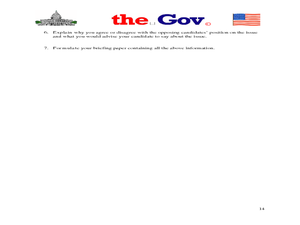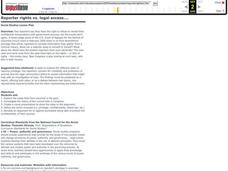Curated OER
Power Plans
In this lesson, young scholars consider what they already know about nuclear power and its uses and then examine an accident at a nuclear power plant. They then research and create reports on nuclear energy.
Federal Reserve Bank
Constitutionality of a Central Bank
Considering the expressed and implied powers of Congress, was it constitutional for the United States to establish the Second National Bank in the early nineteenth century? What is the constitutionality of the Federal Reserve...
Curated OER
The Role of the Judiciary in a System of Separation of Powers and Checks and Balances
Students determine the role of each branch of government in a system of checks and balances. They demonstrate the role of the judiciary in American government
National Constitution Center
Separation of Powers
Learners explore how the Constitution provides for separation of power and limited government, as evidenced by the three branches of government. They participate in role-playing situations, group discussions, and complete worksheets to...
Curated OER
Regents Review Worksheet #1: Principles of the U.S. Constitution
Kids who take the Regents Exam really need to know a lot of information. This is a wonderful exam review tool that includes 26 pages of questions, charts, and suggested readings to help upper graders pass the test. It focuses on all...
Curated OER
The Nonlegislative Powers
Eleventh graders examine the powers of Congress. In this American Government lesson, 11th graders read about Congress. Students complete a worksheet on their findings.
Curated OER
Cartoons for the Classroom: Defining the Separation of Power
In this current events worksheet, students analyze a political cartoon about the separation of powers in the American government and respond to 3 talking point questions.
Curated OER
The Battle for Congress: Midterm Elections 2010
Students research midterm elections. In this United States Congress lesson, students use the Internet to explore the issues, candidates, platforms and stakes of the midterm elections of 2010. This extensive lesson makes use of...
Curated OER
Cartoons for the Classroom: Welcoming the New Congress in Cartoons
In this current events activity, students analyze political cartoons about the 110th Congress. Students respond to 3 talking point questions.
Curated OER
The French Revolution and Napoleon, 1789-1815
Here is an interesting and somewhat interactive presentation. Covering the French Revolution, the slide show begins with a timeline of Napoleon's rise to power and ultimate fall. Main ideas for each event are then outlined with critical...
Curated OER
It's In Your Pocket
Students examine federal powers. In this U.S. Constitution lesson, students explore the powers of Congress to coin money. Students also study the meaning of the symbols on U.S. coins.
Heritage Foundation
Congress's War Powers
Declaring war is not as easy as some may think. High schoolers learn about Congress's limits regarding war by reading important clauses in the US Constitution. Various independent and collaborative activities reinforce learning, making...
Judicial Learning Center
The Power of Judicial Review
Marbury v. Madison is arguably the most important landmark case in the history of the Supreme Court. A fact-filled lesson provides background information about the case and two others related to the concept of judicial review. Scholars...
Curated OER
Congress and the Creation of the Bill of Rights
Students participate in inquiry activities to explore powers outlined in the Bill of Rights. In this Bill of Rights lesson, students creation of a class Bill of Rights, evaluate and propose amendments, and analyze primary source...
Curated OER
Checks on Presidential Power
Students examine presidential powers. In this checks and balances lesson, students identify the constitutional and informal restraints of the president and consider the reasons for the limitations.
National Endowment for the Humanities
George Washington: The Precedent President
Everyone knows that George Washington was the first president, but do your scholars know why that was so important? The lesson plan, the third in a sequence of three, allows learners to understand how George Washington set a precedent...
National Endowment for the Humanities
Lesson 4 James Madison: Internal Improvements Balancing Act—Federal/State and Executive/Legislative
Who has the power? The founding fathers asked the same question when the United States was formed. Learners explore issues that arose during Madison’s presidency that raised constitutional questions. Through discovery, discussion, and...
Curated OER
Congress of Vienna
High schoolers label and locate the 5 European Powers of the congress of Vienna on a map. They describe the goals of the Congress of Vienna by completing a web diagram. Students identify and explain the legacy of the congress of Vienna...
Curated OER
Congress - President: Keeping the Balance
In this checks and balances in U.S. government worksheet, students read a 7-paragraph selection regarding Congress and the President and then respond to 5 short answer questions.
Curated OER
Introduction to the Constitution: The First Three Articles of the Constitution, Separation of Powers
Students review the first three articles of the United States Constitution. In groups, they examine the three branches of government and their function. They follow the path of a bill until it becomes law and discuss Congress' role.
Curated OER
Congress of Vienna/Latin American Revolution
In this Congress of Vienna and Latin American Revolution study guide worksheet, students respond to 16 short answer questions. The questions correlate to assigned readings in a textbook.
Curated OER
Nuclear Power Gets A Boost
Students examine nuclear plants and how they use fission reactions to generate electricity, compare fusion reactions to fission, and read about technology that may soon allow fusion to become practical for producing nuclear power...
Curated OER
Branches of Government
After reading a short text on the branches of government in the United States, future voters answer 8 fill-in-the-blank questions, as well as 11 true or false questions. This worksheet would be a great homework assignment or silent...
Curated OER
Reporter Rights vs. Legal Access...
High schoolers explore cases that have occurred in the past in which reporters refuse to reveal their confidential conversations with government sources and investigate the status of the current bills in Congress. Students use this...
Other popular searches
- Delegated Powers of Congress
- Expressed Powers of Congress
- Express Powers of Congress
- Implied Powers of Congress
- U.s. Congress Powers
- Congressional Powers
- The Powers of Congress
- Powers of Congress Song
- Us Congress Powers
- Expressed Powers Congress
- Explicit Powers of Congress
- Expess Powers of Congress























